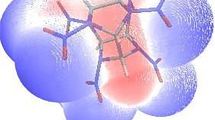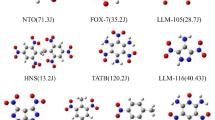Abstract
In order to introduce effectively the external electric fields into the explosive systems, the change trends of the strengths of trigger linkages, nitro group charges, and explosive sensitivities of 1,4-dinitroimidazole-N-oxide (1,4-DNIO) were investigated in the external electric fields at the B3LYP/6–311++G(2d,p) and M06–2X/aug–cc–pVTZ levels. The formulas for calculating the impact sensitivity by the surface electrostatic potentials were discussed. The results show that the N–NO2 bond is always the most likely trigger linkage, followed by N → O. This is the very valuable information for the researchers engaged in the molecular design or synthesis of the energetic explosives: The influences of the weak N → O coordination bond attached to the aromatic ring on the explosive sensitivity can be ignored when the N–NO2 bond exists. In the external electric fields along the positive directions of the N → O and C–NO2 bond axes as well as the negative direction of the N–NO2 bond axis, the dissociation energies (BDEs) of the N–NO2 bond and h50 values are increased, leading to the decreased impact sensitivities. The changes of the bond lengths, AIM electron density values, nitro group charges, BDEs of the trigger linkages, and impact sensitivities correlate well with the external electric field strengths, respectively. The effects of the fields on the electric spark sensitivities and shock initiation pressures are not obvious. The essence of the low BDEs of the N–NO2 bond was revealed by the resonance theory of the aromatic ring.

Changes of the impact sensitivities versus field strengths






Similar content being viewed by others
References
Tasker D (1985) The properties of condensed explosives for electromagnetic energy coupling. NSWC TR 85–360
Demske D (1982) The experimental aspects of coupling electrical energy into a dense detonation wave: part 1. NSWC TR 79–143
Lee EA, Drake RC, Richardson J (2014) A view on the functioning mechanism of EBW detonators -part 3: explosive initiation characterisation, 18th APS-SCCM, USA
Abdulazeem MS, Alhasan AM, Abdulrahmann S (2011) Initiation of solid explosives by laser. Int J Therm Sci 50:2117–2121
Borisenok VA, Mikhailov AS, Bragunets VA (2011) Investigation of the polarization of explosives during impact and the influence of an external electric field on the impact sensitivity of superfine PETN. Russ J Phys Chem B 5:628–639
Rodzevich AP, Gazenaur EG, Kuzmina LV, Krasheninin VI, Gazenaur NV (2017) The effect of electric field in the explosive sensitivity of silver Azide. J Phys Conf Ser 830:012131–1~6
Piehler T, Hummer C, Benjamin R, Summers E, McNesby K, Boyle V (2013) Preliminary study of coupling electrical energy to detonation reaction zone of primasheet-1000 explosive, 27th international symposium on ballistics, freiburg, Germany, pp 22–26
Ren FD, Cao DL, Shi WJ (2016) A dynamics prediction of nitromethane→methyl nitrite isomerizatioin in external electric field. J Mol Model 22:96
Ren FD, Cao DL, Shi WJ, You M (2017) A dynamics prediction of stability for nitromethane in external electric field. RSC Adv 7:47063–47072
Grinenko A, Efimov S, Fedotov A, Krasik YE, Schnitzer I (2006) Efficiency of the shock wave generation caused by underwater electrical wire explosion. J Appl Phys 100:113509–1~8
Sarkisov GS, Rosenthal SE, Struve KW (2007) Thermodynamical calculation of metal heating in nanosecond exploding wire and foil experiments. Rev Sci Instrum 78:043505–1~5
Politzer P, Murray JS, Concha MC, Lane P (2007) Effects of electric fields upon energetic molecules: nitromethane and dimethylnitramine. Cent Eur J Energ Mater 4:3–21
Politzer P, Murray JS, Lane P (2009) Computational determination of effects of electric fields upon “trigger linkages” of prototypical energetic molecules. Int J Quantum Chem 109:534–539
Politzer P, Murray JS (2009) Computed effects of electric fields upon the C–NO2 and N–NO2 bonds of nitromethane and dimethylnitramine. Int J Quantum Chem 109:3–7
Song X, Ji S, Cheng X (2007) The molecular properties of some nitrobenzene explosives in elecric field. J At Mol Phys 24:916–920
Li JS (2010) A quantitative relationship for the shock sensitivities of energetic compounds based on X–NO2 (X = C, N, O) bond dissociation energy. J Hazard Mater 180:768–772
Cao CZ, Gao S (2007) Two dominant factors influencing the impact sensitivities of nitrobenzenes and saturated nitro compounds. J Phys Chem B 111:12399–12402
Lv L, Wei Y, Tao Z, Yang F, Wu D, Yang M (2017) Effect of an external electric field on the C-N cleavage reactions in nitromethane and triaminotrinitrobenzene. Comput Theor Chem 1117:215–219
Tao Z, Wang X, Wei Y, Lv L, Wu D, Yang M (2016) A theoretical study of molecular structure, optical properties and bond activation of energetic compound FOX-7 under intense electric fields. Chem Phys 483–484:122–131
Wang WJ, Sun XJ, Zhang L, Lei F, Guo F, Yang S, Fu QB (2019) Sub-microsecond interferometry diagnostic and 3D dynamic simulation of the bridgewire electrical explosion. Chin J Energ Mater 27:473–480
Ren FD, Cao DL, Shi WJ, You M, Li M (2015) A theoretical prediction of the possible trigger linkage of CH3NO2 and NH2NO2 in an external electric field. J Mol Model 21:145
Li P, Zhang C, Ren FD, Cao Q, Li XJ, Cao RL (2017) Theoretical insight into the structure and stability of TNT and RDX in external electric field. Indian J Pure Appl Phys 55:604–615
Feng R, Zhang S, Ren F, Wang C (2016) Theoretical study on the sensitivity of HMX/FOX-7 cocrystal explosive with different molecular molar ratios in external electric fields. Chem Res Appl 28:479–486
Li Z, Huang H, Zhang T, Zhang S, Zhang J, Yang L (2014) First–principles study of electric field effects on the structure, decomposition mechanism, and stability of crystalline lead styphnate. J Mol Model 20:2072–2079
Ravi SP, Tewari P (2012) Theoretical investigations on the structure, density, thermodynamic and performance properties of amino-, methyl-, and nitroimidazoles and their N-oxides. Struct Chem 23:1953–1970
Politzer P, Murray JS (2017) Nitro groups vs. N-oxide linkages: effects upon some key determinants of detonation performance. Cent Eur J Energ Mater 14:3–25
Lobbecke S, Pfeil A, Krause H (1999) Thermal analysis of different nitro furoxans. 30th Int. Annu Conf of ICT [C]
Frisch MJ, Trucks GW, Schlegel HB et al (2009) Gaussian 09. Inc., Wallingford CT
Bader RFW (1990) Atoms in molecules, a quantum theory. Oxford University Press, Oxford
Murray JS, Politzer P (2011) The electrostatic potential: an overview. WIREs Comput Mol Sci 1:153–163
Zhang C, Shu Y, Huang Y, Zhao X, Dong H (2005) Investigation of correlation between impact sensitivities and nitro group charges in nitro compounds. J Phys Chem B 109:8978–8982
Li JS (2010) A multivariate relationship for the impact sensitivities of energetic N-nitrocompounds based on bond dissociation energy. J Hazard Mater 171:728–733
Song XS, Cheng XL, Yang XD, He B (2006) Relationship between the bond dissociation energies and impact sensitivities of some nitro–explosives. Propell Explos Pyrot 31:306–310
Tan B, Long X, Peng R, Li H, Jin B, Chu S, Dong H (2010) Two important factors influencing shock sensitivity of nitro compounds: bond dissociation energy of X–NO2 (X = C, N, O) and Mulliken charges of nitro group. J Hazard Mater 183:908–912
Zhao J, Xu DH, Cheng XL (2010) Investigation of correlation between impact sensitivities and bond dissociation energies in some triazole energetic compounds. J Struct Chem 21:1235–1240
Rice BM, Hare JJ (2002) A quantum mechanical investigation of the relation between impact sensitivity and the charge distribution in energetic molecules. J Phys Chem A 106:1770–1783
Shao J, Cheng X, Yang X, Zhang F, Ge S (2006) Calculations of bond dissociatioin energies and bond lengths of C–H, C–N, C–O, N–N. J At Mol Phys 23:80–84
Bulusu SN (1990) Chemistry and physics of energetic materials. Kluwer Academic Publishers
Schleyer PR, Maerker C, Dransfeld A, Jiao H, van Eikema Hommes NJR (1996) Nucleus-independent chemical shifts: a simple and efficient aromaticity probe. J Am Chem Soc 118:6317–6318
Bracuti AJ (1996) Molecular structure of a new potential propellant oxidize 4,5-dinitroimdazole. J Chem Crystallogr 28:367–371
Wang J, Dong H, Zhang X (2010) Synthesis, thermal stability and sensitivity of 2,4-dinitroimdazole. Chin J Energ Mater 18:728–729
Murray JS, Lane P, Politzer P (1998) Effects of strongly electron-attracting components on molecular surface electrostatic potentials application to predicting impact sensitivities of energetic molecules. Mol Phys 93:187–194
Zhi C, Cheng X (2010) The correlation between electric spark sensitivity of polynitroaromatic compounds and their molecular electronic properties. Propell Explos Pyrot 35:555–560
Cohen R, Zeiri Y, Wurzberg E, Kosloff R (2007) Mechanism of thermal unimolecular decomposition of TNT (2,4,6-trinitrotoluene): a DFT study. J Phys Chem A 111:11074–11083
Fayet G, Joubert L, Rotureau P, Adamo C (2009) A theoretical study of the decomposition mechanisms in substitutedo-nitrotoluenes. J Phys Chem A 113:13621–13627
Kiselev VG, Gritsan NP (2014) Unexpected primary reactions for thermolysis of 1,1-Diamino-2,2-dinitroethylene (FOX-7) revealed by ab initio calculations. J Phys Chem A 118:8002–8008
Shaik S, Mandal D, Ramanan R (2016) Oriented electric fields as future smart reagents in chemistry. Nat Chem 22:1091–1098
Zhou ZJ, Li XP, Liu ZB, Li ZR, Huang XR, Sun CC (2011) Electric field-driven acid-base chemistry: proton transfer from acid (HCl) to base (NH3/H2O). J Phys Chem A 115:1418–1422
Sason S, Sam P d V, Devesh K (2004) External electric field will control the selectivity of enzymatic-like bond activations. J Am Chem Soc 126:11746–11749
Chen J, Reed MA, Rawlett AM, Tour JM (1999) Large on-off ratio and negative differential resistance in a molecular electronic device. Science 286:1550–1552
Kumar N, Sandi G, Kaminski M, Bobadilla A, Mertz C, Seminario JM (2015) Electron transport in graphene-based nanosensors for Eu (III) detection. J Phys Chem C 119:12037–12046
Benitez L, Cristancho D, Seminario JM, Martinez de la Hoz JM, Balbuena PB (2014) Electron transfer through solid-electrolyte-interphase layers formed on Si anodes of Li-ion batteries. Electrochim Acta 140:250–257
Politzer P, Murray JS (2016) High performance, low sensitivity: conflicting or compatible? Propell Explos Pyrotech 41:414–425
Politzer P, Murray JS (2015) Impact sensitivity and the maximum heat of detonation. J Mol Model 21:262
Author information
Authors and Affiliations
Corresponding author
Ethics declarations
Ethical statement
We allow the journal to review all the data, and we confirm the validity of results. There is none of the financial relationships. This work was not published previously and it is not submitted to more than one journal. It is also not split up into several parts to submit. No data have been fabricated or manipulated.
Additional information
Publisher’s note
Springer Nature remains neutral with regard to jurisdictional claims in published maps and institutional affiliations.
Electronic supplementary material
The selected structural parameters, AIM results, Mulliken and APT charges of the nitro groups of 1,4-DNIO in the different external electric field strengths and orientations at the B3LYP/6–311++G(2d,p) and M06–2X/aug–cc–pVTZ levels are shown in Table S1.
ESM 1
(DOCX 33 kb)
Rights and permissions
About this article
Cite this article
Wang, Bg., Ren, Fd. & Wang, Y. Theoretical prediction of the trigger linkages, surface electrostatic potentials, and explosive sensitivities of 1,4-dinitroimidazole-N-oxide in the external electric fields. J Mol Model 25, 368 (2019). https://doi.org/10.1007/s00894-019-4258-2
Received:
Accepted:
Published:
DOI: https://doi.org/10.1007/s00894-019-4258-2




